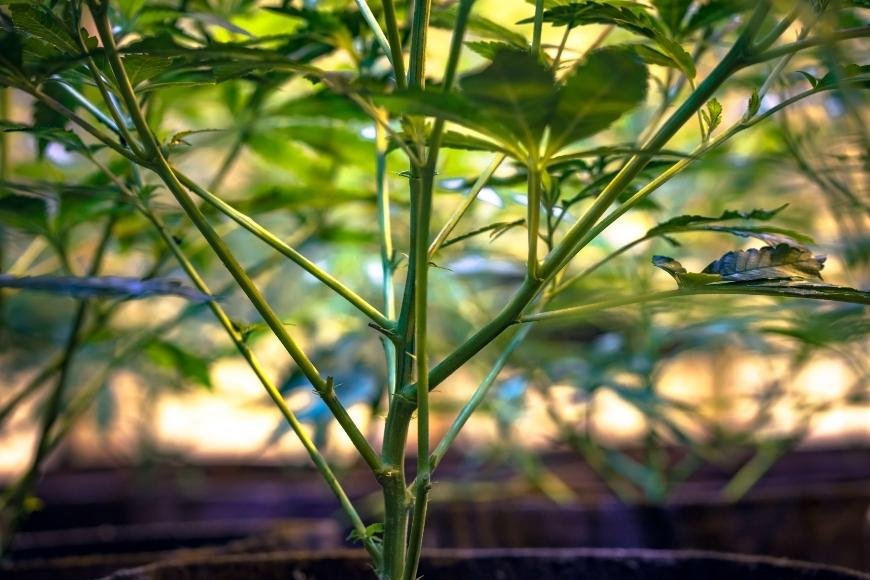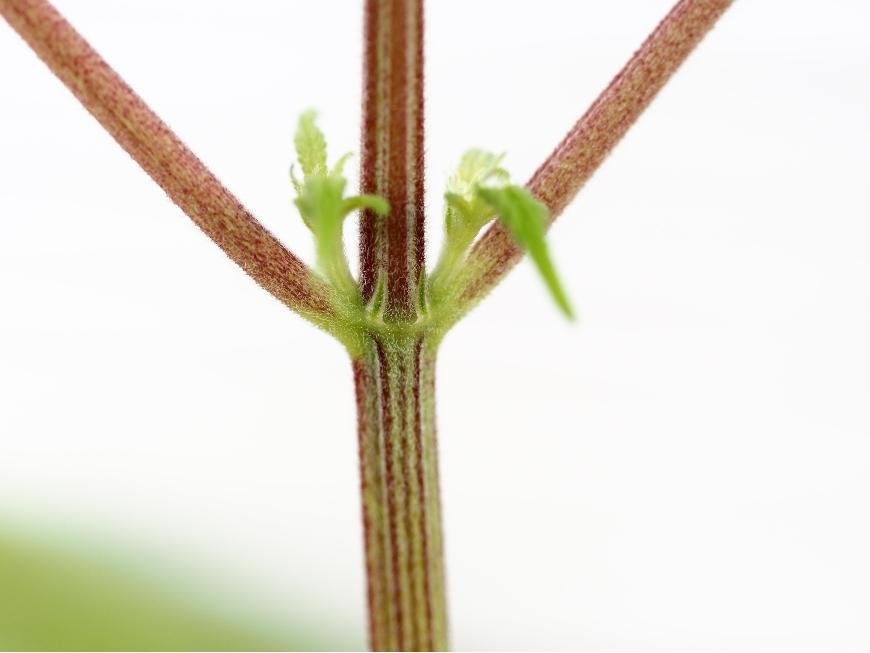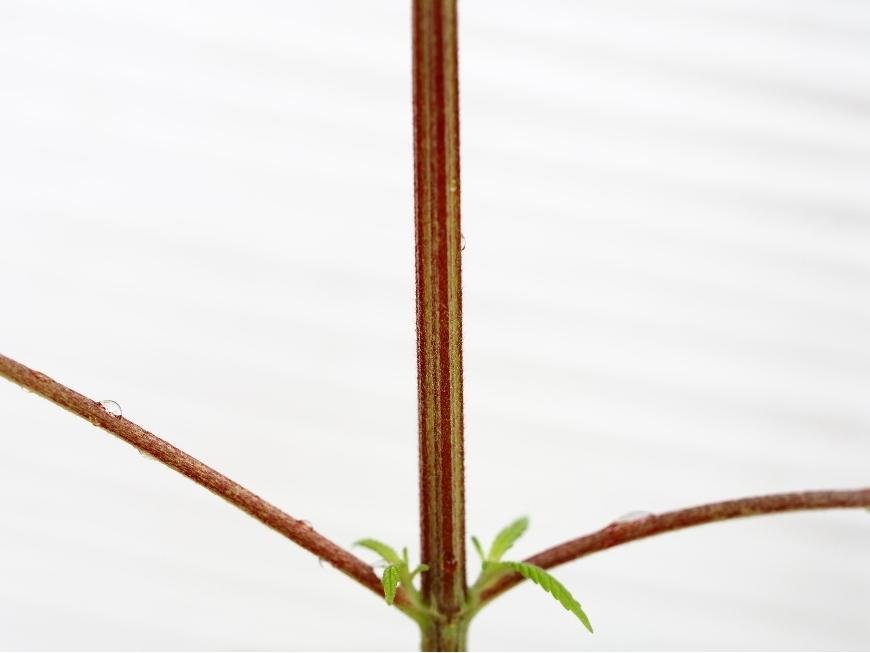How to Fix Phosphorus Deficiency in Cannabis Plants
Learn how to fix phosphorus deficiency in cannabis plants with our guide on soil pH, fertilizers, and creating optimal growing conditions.

When it comes to growing healthy cannabis plants, understanding how to fix phosphorus deficiency is essential. Maintaining the right amount of phosphorus in cannabis plants is essential for ensuring their optimal growth, and this guide will provide strategies to do just that.
In this comprehensive guide on fixing phosphorus deficiency in cannabis plants, we will discuss various strategies that can help you maintain optimal plant growth. We will explore methods such as adjusting soil pH levels, providing adequate light and water, using organic or synthetic fertilizers effectively, avoiding over-fertilization, testing soil regularly, and creating an ideal environment for your weed plants.
Armed with this knowledge on how to fix phosphorus deficiency in cannabis plants, you'll be better equipped to produce robust and thriving marijuana crops with impressive yields.
Table of Contents:
- Identifying Phosphorus Deficiency in Cannabis Plants
- Signs of Phosphorus Deficiency
- Adjusting Soil pH Level
- Providing Adequate Light and Water
- Using Organic or Synthetic Fertilizers
- Avoiding Over-Fertilizing
- Testing Soil Regularly
- Creating Optimal Growing Conditions
- Conclusion
Identifying Phosphorus Deficiency in Cannabis Plants
Phosphorus is a key component for the flourishing of cannabis plants, being essential to such activities as energy transfer, photosynthesis and root development. Phosphorus is vital for energy transfer, photosynthesis and root growth in cannabis plants. A phosphorus deficiency can negatively impact your plant's overall health and yield. To effectively fix this issue, it's important to first identify the signs of phosphorus deficiency in your cannabis plants.
Signs of Phosphorus Deficiency
- Slow Growth: One of the most noticeable symptoms is slow or stunted growth. This occurs because phosphorus is vital for cell division and expansion within the plant.
- Dark Green Leaves: When there isn't enough phosphorus available, leaves may become darker green than usual due to an increase in chlorophyll production.
- Purple Stems: Another common sign of phosphorus deficiency is purple or red coloration on stems and petioles (the stalk that connects a leaf to its stem). This happens because anthocyanin pigments accumulate when there's insufficient phosphorous present.
- Brown Leaf Tips & Curling Edges: Your cannabis plant might also exhibit brown tips on older leaves along with curling edges as a result of inadequate amounts of phosphorous.
If you notice any combination these symptoms affecting your cannabis plants, it's likely they are suffering from a lack of sufficient phosphorous levels. Keep reading our guide on how to fix this problem by adjusting soil pH level, providing adequate light and water conditions among other methods.

Adjusting Soil pH Level
One of the key factors in fixing phosphorus deficiency in cannabis plants is adjusting the soil's pH level. The optimal pH range for cannabis plants to absorb phosphorus effectively is 6.0-7.0 in soil and 5.5-6.5 in hydroponic systems; outside this range, nutrient lockout may occur, impeding your plants' uptake of vital nutrients such as phosphorus. When the pH falls outside this range, it can lead to nutrient lockout, preventing your plants from absorbing essential nutrients like phosphorus.
To adjust your soil's pH level, you'll need a pH testing kit or digital meter to measure the current levels accurately. Once you know your soil's current pH value, follow these steps:
- If your soil is too acidic (below 6.0), add dolomite lime or wood ash gradually until you reach the desired range.
- If your soil is too alkaline (above 7.0), use sulfur or aluminum sulfate cautiously to lower the pH back into an optimal zone.
Remember that making drastic changes quickly can stress out your cannabis plants; instead, make gradual adjustments over time by monitoring and retesting regularly until you achieve stable results within the recommended ranges.
Maintaining Proper Soil Moisture Levels
In addition to adjusting the overall acidity of your growing medium, ensuring proper moisture levels also plays a crucial role in helping correct phosphorus deficiencies in cannabis plants as it facilitates better nutrient uptake through roots system.
To maintain adequate moisture levels:
- Avoid overwatering: Excessive water can cause root rot and create anaerobic conditions that limit nutrient absorption capabilities.
- Allow the soil to dry out slightly between waterings: This helps oxygenate the root zone and promotes healthier nutrient uptake.
- Consider using a moisture meter: A simple tool that can help you monitor your plant's watering needs more accurately, ensuring they receive just enough without overdoing it.
Checking and sustaining suitable soil dampness, together with monitoring your cannabis plants' pH levels, is a surefire way to address phosphorus deficiency and aid them in flourishing in their growing environment. Remember that consistency is key - regularly test and adjust as needed for optimal results.
Providing Adequate Light and Water
Phosphorus deficiency in cannabis plants can be exacerbated by inadequate lighting and improper watering. Ensuring your plants receive the right amount of light and water is crucial for their overall health, as well as for correcting phosphorus deficiencies. In this section, we will explore the significance of providing appropriate illumination and hydration to your cannabis plants.
The Importance of Proper Lighting
Cannabis plants require a specific spectrum of light to thrive, especially during the flowering stage when they need more phosphorus. The type of grow lights you use plays a significant role in providing the necessary wavelengths for optimal growth. Some popular options include LEDs (Light Emitting Diodes), HPS (High-Pressure Sodium) bulbs, or MH (Metal Halide) lamps.
- LEDs: These energy-efficient lights emit a full spectrum suitable for all stages of plant growth while producing less heat than other types of grow lights.
- HPS: High-pressure sodium bulbs are ideal during the flowering stage due to their red-orange spectral output that promotes bud development but may require additional cooling measures because they generate more heat.
- MH: Metal halide lamps offer an excellent blue-white spectrum perfect for vegetative growth but should be replaced with HPS bulbs once your cannabis enters its flowering phase.
To ensure proper lighting conditions, maintain an appropriate distance between your grow lights and the canopy - too close could cause burns or stunted growth; too far away might result in insufficient light absorption leading to poor nutrient uptake including phosphorus.
Watering Your Cannabis Plants Correctly
Overwatering or underwatering your cannabis plants can lead to nutrient imbalances, including phosphorus deficiency. To maintain a healthy balance, it's essential to monitor the moisture level of your growing medium and adjust watering practices accordingly.
- Check soil moisture: Use your finger or a moisture meter to assess the dampness of the soil before watering. If it feels dry an inch below the surface, it's time for water; if not, wait another day or two.
- Avoid overwatering: Overwatered cannabis plants are more susceptible to root rot and other diseases that hinder nutrient uptake. Allow the top layer of soil to dry out between waterings while ensuring roots remain moist but not saturated.
- Maintain proper drainage: Ensure that excess water can easily drain from your pots by using well-draining soils and containers with holes at their base. This prevents stagnant water which could lead to root rot and impede nutrient absorption like phosphorus.
Properly providing adequate light and water is essential for healthy cannabis plants. Employing either organic or manufactured fertilizers can assist in making sure the necessary nutrition of your cannabis plants is met, yet it's critical to recognize when and how much fertilizer should be utilized.
Using Organic or Synthetic Fertilizers
One way to ensure your cannabis plants receive the phosphorus they need is through the use of organic or synthetic fertilizers, which can provide essential nutrients and help promote growth. Using products with necessary nutrients, such as phosphorus, may assist in promoting your plant's development and wellbeing. Here are some popular options for both organic and synthetic fertilizers:
Organic Fertilizers
- Bone meal: A natural source of phosphorus derived from animal bones.
- Worm castings: The nutrient-rich waste produced by earthworms contains a good amount of phosphorous.
- Soft rock phosphate: A mineral-based fertilizer that provides a slow-release form of phosphorus.
- Bat guano: An excellent source of fast-releasing phosphorous, as well as other vital nutrients for cannabis plants.
Synthetic Fertilizers
- NPK (Nitrogen-Phosphorus-Potassium) ratios: When choosing a synthetic fertilizer, look for those with higher phosphorus content, such as a 1-3-2 or 0-10-10 NPK ratio.
- Specialized cannabis-friendly nutrients: There are many nutrient lines specifically designed for growing marijuana plants. These products often contain the right balance of essential nutrients, including phosphorus, to support healthy plant growth and flowering.
To fix phosphorus deficiency in your cannabis plants using these fertilizers, follow the manufacturer's instructions on application rates and frequency. Too much fertilizer can result in other nutrient problems or disparities, so it's important to be careful when applying. Always monitor your plant's response after applying any fertilizer and adjust accordingly if needed.
Organic fertilizers can be an effective solution for correcting phosphorus deficiencies in cannabis plants, but it's essential to be cautious not to give too much. Be mindful of not providing too much fertilizer to your plants by adhering to the instructions and monitoring nutrient levels.
Avoiding Over-Fertilizing
When attempting to fix phosphorus deficiency in cannabis plants, it's crucial not to overdo it with fertilizers. Over-fertilizing can lead to nutrient burn and other issues that may harm your plants even more. It is essential to be aware of the proper fertilizer amount, as over-fertilization can have detrimental effects on cannabis plants.
The Dangers of Over-Fertilization
Applying too much fertilizer can cause a variety of problems for your cannabis plants, including:
- Nutrient Burn: Excess nutrients in the soil can damage plant roots and leaves, leading to yellow or brown spots on foliage.
- Nutrient Lockout: An imbalance caused by excessive amounts of one nutrient may prevent your plants from absorbing others properly.
- Weakened Immune System: Plants stressed by an excess of nutrients are more susceptible to pests and diseases.
To avoid these issues, it's essential to apply fertilizers containing phosphorus carefully and monitor their effects on your cannabis plants closely.
Tips for Avoiding Over-Fertilization
- Start Slowly: Begin with a lesser quantity of fertilizer than the label indicates if you're not sure about how much to use. You can always add more later if necessary but removing excess nutrients from soil is challenging once they've been applied.
- Maintain Proper pH Levels: Your cannabis plant's ability to absorb phosphorus depends largely on maintaining proper pH levels in the growing medium (soil or hydroponic system). Keep an eye on pH levels and adjust them as needed to ensure optimal nutrient uptake.
- Monitor Plant Health: Regularly inspect your plants for signs of stress or nutrient burn, such as yellowing leaves or brown spots. If you notice any issues, consider reducing the amount of fertilizer you're using.
- Test Soil Regularly: To avoid over-fertilizing, it's essential to test your soil regularly and make adjustments based on the results. This will help ensure that your cannabis plants receive just the right balance of nutrients they need without going overboard. Check out our section on testing soil regularly for more information.
By avoiding over-fertilizing, cannabis plants can be kept healthy and strong. To guarantee flourishing growth, soil should be examined periodically to ascertain that the nutrient content is at an ideal level.

Testing Soil Regularly
To effectively fix phosphorus deficiency in cannabis plants, it is crucial to test the soil regularly. This helps you monitor the nutrient levels and make necessary adjustments. In this section, we will discuss why testing your soil is essential and how to do it correctly.
The Importance of Soil Testing
Soil testing allows you to:
- Determine the current nutrient levels in your soil, including phosphorus.
- Identify any imbalances or deficiencies that may be affecting your cannabis plants' growth and development.
- Select appropriate fertilizers based on your plants' specific needs.
- Avoid over-fertilizing, which can harm your plants and lead to further issues such as nutrient lockout or toxicity.
Regular soil testing ensures that you are providing an optimal environment for your cannabis plants by maintaining a proper balance of nutrients. It also helps prevent potential problems before they become severe enough to impact plant health negatively.
How to Test Your Soil for Phosphorus Levels
You can test the phosphorus levels in your soil using either a home test kit or by sending a sample off for professional analysis. Here's how:
- Home Test Kit: Purchase a reliable home test kit from a gardening store or online retailer. These kits typically include instructions on collecting samples and interpreting results. Make sure you choose one specifically designed for measuring phosphorus content.
- Professional Soil Analysis: If you prefer a more accurate and comprehensive analysis, consider sending your soil sample to a professional soil testing lab. They will provide detailed information on nutrient levels, pH balance, and other essential factors that affect cannabis plant growth.
It is imperative to test your soil frequently, at least once every growing season, in order to identify any changes in nutrient levels quickly and effectively correct phosphorus deficiency. This ensures that any changes in nutrient levels are detected early enough for corrective action.
Testing soil regularly is essential to ensure your cannabis plants have the optimal nutrients they need for healthy growth. By creating optimal growing conditions, you can further increase the chance of a successful harvest.
Creating Optimal Growing Conditions
To fix phosphorus deficiency in cannabis plants, it's essential to create optimal growing conditions that promote healthy growth and nutrient absorption. Ensuring the right lighting, moisture levels and temperature can help your plants grow healthily and combat any deficiencies.
Proper Lighting
Cannabis plants require a specific light spectrum for optimal growth. During the vegetative stage, they need more blue light (around 400-500 nm), while during the flowering stage, red light (around 620-780 nm) is crucial. To provide your plants with the right amount of light throughout their lifecycle:
- Use full-spectrum LED grow lights or high-pressure sodium (HPS) lamps.
- Maintain an appropriate distance between the lights and your plants to prevent burning or stunted growth.
- Adjust the duration of daily light exposure according to each plant's needs: typically 18 hours per day during vegetation and 12 hours per day during flowering.
Humidity Control
The ideal relative humidity level for cannabis varies depending on its developmental stage:
- Vegging phase: around 60%
- Blooming phase: around 40%
- Late blooming/ripening phase: about 30%-35%
Temperature Control
Optimal temperature ranges for cannabis plants are:
- Vegging phase: 70-85°F (21-29°C)
- Blooming phase: 65-80°F (18-26°C) with a drop of about 10°F (5.5°C) during the dark period
By creating optimal growing conditions for your cannabis plants, you'll not only help them overcome phosphorus deficiency but also ensure they have everything they need to thrive. Remember that healthy plants are more resilient and better equipped to handle nutrient deficiencies when they occur. So, always pay close attention to lighting, humidity, and temperature control for the best possible results.
Conclusion
Fixing phosphorus deficiency in cannabis plants is crucial for healthy growth and maximum yield. By identifying the signs of deficiency, adjusting soil pH levels, providing adequate light and water, using organic or synthetic fertilizers, avoiding over-fertilizing, testing soil regularly and creating optimal growing conditions, growers can ensure their plants thrive.
In conclusion, it's important to pay close attention to your cannabis plants' nutrient needs to avoid deficiencies like phosphorus. Taking the necessary steps outlined above will help you fix any issues that arise and keep your plants healthy throughout their growth cycle.


























































































































